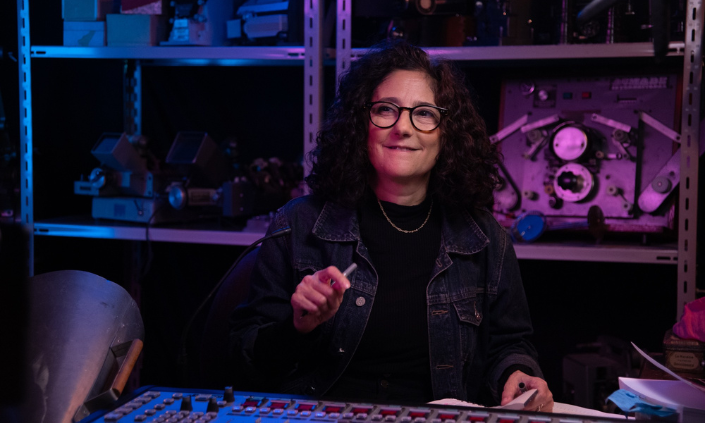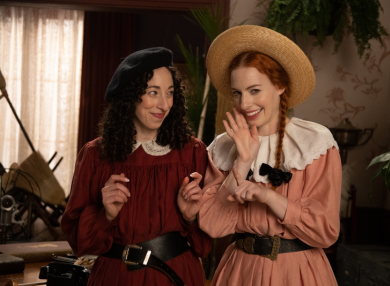Five minutes with…A/Prof Karen Pearlman ASE
In this profile we speak with Associate Professor Karen Pearlman about her career in feminist film histories and her latest work 'Breaking Plates.'

What is your background and what brought you to Macquarie?
I’m a filmmaker and film scholar, so Macquarie University attracted me through its inspiring leadership in creative practice research and film, the impressive work of my dynamic colleagues in Screen, and the brilliant facilities we have in 10HA – a building familiar to me since I did my Masters in Editing there, back when it was the Australian Film, Television and Radio School.
Before turning to filmmaking, I was a professional dancer, mostly in New York, but also as an Artistic Director of companies here. The dancing expertise informed my PhD which investigates film editing as a choreographic art. The PhD became my book Cutting Rhythms, which is going into its third edition this year, with lots of new ideas about editing creativity and cognition, developed through my research here at Macquarie, with thanks to my inspiring colleagues and our brilliant facilities!
Tell us a bit about your current research and what makes it so important?
My research is into creative practice, cognition and feminist film histories and it is through the mix of these three that I am making a difference to the stories we tell about film history, the ways we understand authorship, and, I hope, the ways we work together.
To unpack that a bit: by developing my own expertise in creative practice of filmmaking, I can speak from experience about how ideas are generated in the ‘distributed cognitive system’ we call a film crew. I understand how the thinking of creative people is ‘embodied’ and ‘embedded’ and I can see their thinking in their films, even when it has not been written about in archival documents.
From there, it is possible to look back at history and understand that the women who were working in cinema 100 years ago were not ‘just helping’, they were creative and intellectual participants in the generation of film form! We can see this in their work – their edits, their performances, their productions, their stories. We can also use their film archives to make new films – to tell these women’s stories using the innovations they are (or should be) known for.
This has been an impactful strategy for addressing what Professor Jane Gaines calls the ‘unequal distribution of narrative wealth’ about women in film. It has also made a difference to understanding ‘authorship’ or where ideas come from in film. My creative and critical works make the case that films are not the sole creation of one person’s brain, but the distributed creativity of many brains, bodies, tools and contexts.
Is there something you would like staff to know about?
Lately, I’ve begun to think that this work of understanding creativity as distributed could be important to culture more broadly too. The unspoken and vital aspects of creativity and collaboration between humans with unique experiences and insights are under threat from digital systems that do not have bodies or personal histories. And when ease and efficiency are valued over the richness that can only come from developing expertise, insight and wisdom over time, through effort and coordination with others, we are in trouble.
What is something you have recently accomplished?
In 2025 it will look like I have ‘recently accomplished’ writing a new book, revising and publishing the third edition of my first book, and creating a new award-winning film. But, in fact, each of these things has taken years, they just all happen to be coming out this year!
The new book is about Shirley Clarke (1919-1997), who I often call: ‘the greatest filmmaker you never heard of.’ I was inspired to write it when I learned that Clarke was a dancer turned film editor turned film director. Sound familiar? I thought, given that I went through this same progression, and then developed a critical framework for articulating artistry in these different forms, I could make a contribution to understanding how she drew ideas and ways of working from the skills and culture of dance and editing into directing. The book, Shirley Clarke, Thinking Through Movement, is available to download open access (free!) from the Edinburgh University Press website.
What is on your agenda for 2025?
I’m excited for international screenings of the new film, Breaking Plates, a raucous documentary about the not-so-silent women of the silent film era. Breaking Plates is an international collaboration with the curators of the 4-DVD set Cinema’s First Nasty Women, and a collaboration with the 99 films in the collection. It is a creative conversation between women of the past and the present. If you’re curious, here is a trailer.

What do you need to do your best work?
What I need to do my best work, in fact any work, is the grace of space and time, and the inspiration and curiosity of collaborators. I shout out here to my long-time partner in life and work, Richard James Allen, who produces the films I direct, often performs in them, and is (to stretch a metaphor for all the Star Trek fans out there) my Klingon second spine. If you’re not a Star Trek fan (he is), you’ll just have to look it up!
Violette Ayad & Emma Watkins in 'Breaking Plates' (c) 2025 The Physical TV Company